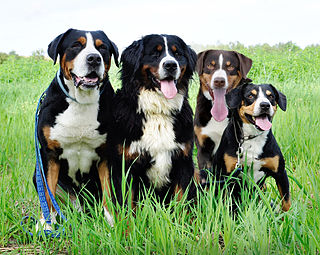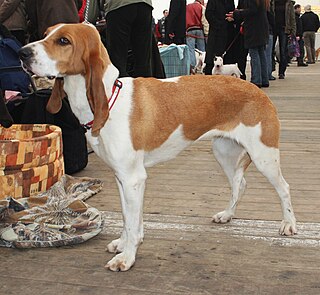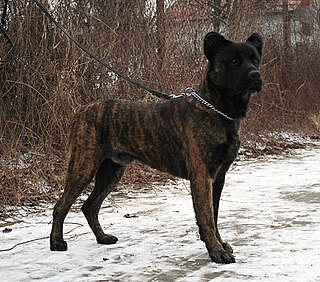
The Bernese Mountain Dog is a large dog breed from Bern, Switzerland and the Swiss Alps, being one of the four breeds of Sennenhund-type dogs, with roots in the Roman mastiffs. The name Berner refers to the breed's area of origin in the canton of Bern, and Sennenhund is derived from the German Senne and Hund ("hound/dog"), as they accompanied the alpine herders and dairymen called Senn. This breed was originally kept as a general farm dog and large Sennenhunde in the past were also used as draft animals pulling carts. The breed was officially established in 1912.

The Fédération cynologique internationale is the largest international federation of national kennel clubs and purebred registries. The FCI is based in Thuin, Belgium and has 98 members and contract partners.

The Entlebucher Sennenhund or Entlebucher Mountain Dog is a medium-sized herding dog, it is the smallest of the four regional breeds that constitute the Sennenhund dog type. The name Sennenhund refers to people called Senn, herders in the Swiss Alps. Entlebuch is a region in the canton of Lucerne in Switzerland. The breed is also known in English as the Entelbuch Mountain Dog, Entelbucher Cattle Dog, and similar combinations.

The Bergamasco Shepherd, Italian: Cane da Pastore Bergamasco, is an Italian breed of sheepdog. It originated in the Alpi e Prealpi Bergamasche, where it was used as a herding dog for both sheep and cattle.

The Greater Swiss Mountain Dog is a dog breed which was developed in the Swiss Alps. The name Sennenhund refers to people called Senn or Senner, dairymen and herders in the Swiss Alps. Greater Swiss Mountain Dogs are almost certainly the result of indigenous dogs mating with large mastiff-type dogs brought to Switzerland by foreign settlers. At one time, the breed was believed to have been among the most popular in Switzerland. It was assumed to have almost died out by the late 19th century, since its work was being done by other breeds or machines, but was rediscovered in the early 1900s.

Albert Heim was a Swiss geologist, noted for his three-volume Geologie der Schweiz.

The Schnauzer or Mittelschnauzer is a German breed of dog in the Pinscher and Schnauzer group. It is characterised by an abundant bristly beard and whiskers, usually lighter than the coat. It is one of three Schnauzer breeds, the others being the Giant Schnauzer or Riesenschnauzer, and the Miniature Schnauzer or Zwergschnauzer. In Germany it is an endangered breed, and is listed in category III of the Rote Liste of the Gesellschaft zur Erhaltung alter und gefährdeter Haustierrassen.

Sennenhunds, called Swiss mountain dogs or Swiss cattle dogs in English, are a type of dog originating in the Swiss Alps. The Sennenhund are farm dogs of the general livestock guardian type. There are four breeds of Sennenhunds, all sporting a unique tricolor coat. While the two larger ones share a heavy build and a calm temperament, the two smaller ones are more agile. The breeds range from medium in size to very large. The name Sennenhund refers to people called Senn or Senner, Swiss Alpine herdsmen and dairymen, and does not translate as "mountain" or "cattle".

The Braunvieh or Swiss Brown is a breed or group of breeds of domestic cattle originating in Switzerland and distributed throughout the Alpine region. It falls within the "Brown Mountain" group of cattle breeds. The Swiss Braunvieh was originally a triple-purpose animal, used for milk production, for meat and for draught work; the modern Braunvieh is predominantly a dairy breed.

The German Pinscher or Deutscher Pinscher is a German breed of terrier in the Pinscher and Schnauzer group. It shares common origins with the Schnauzer, of which it is essentially a short-haired equivalent. It is seen in two colours, either black-and-tan or self-coloured red, this varying from deer-red to a dark reddish brown.

The Kromfohrländer is a modern German breed of companion dog. It originated in Germany in the years after the end of the Second World War. There are two coat types, a smooth-haired and a rough-haired.

The Schweizer Laufhund is a group of overlapping scenthounds, originating from Switzerland. The breed has several different varieties.

The Saint Miguel Cattle Dog is a dog breed of mastiff type originating on São Miguel Island in the Azores, an island chain which is one of the autonomous regions of Portugal. The breed was originally used as a herding dog for working with cattle.

The White Swiss Shepherd Dog or Berger Blanc Suisse is a Swiss breed of shepherd dog. It descends from North American White Shepherds imported to Switzerland; the White Shepherd itself descends from white-coloured purebred German Shepherds.

The Appenzeller Spitzhauben is a Swiss breed of crested chicken originating in the historical Appenzell region of Switzerland. It is one of two chicken breeds from that area, the other being the Appenzeller Barthuhn; the only other Swiss breed of chicken is the Schweizer.

The Appenzell, French: Chèvre d’Appenzell, German: Appenzellerziege, is a rare and endangered indigenous breed of white domestic goat from Switzerland. It originates in the "half-cantons" of the historic Appenzell region, Appenzell Ausserrhoden and Appenzell Innerrhoden, and has spread into the neighbouring Canton of St. Gallen.

The Schweizer, German: Schweizerhuhn or "Swiss chicken", is a Swiss breed of domestic chicken. It was bred in 1905 in Amriswil, in the canton of Thurgau, in north-east Switzerland. It is kept mainly in German-speaking areas of the country. It is one of three Swiss chicken breeds, the others being the Appenzeller Barthuhn and the Appenzeller Spitzhauben.

The Continental Bulldog, or Conti for short, is a newer dog breed created in Switzerland. It is officially recognized by the FCI since 2022.

The Barbado da Terceira is Portuguese breed of herding and guard dog from the Atlantic island of Terceira in the Azores, for which it is named. It was recognised by the Direcção-Geral de Veterinária of Portugal in 2004. It is not recognised by the Fédération Cynologique Internationale.

The Appenzeller Barthuhn is a Swiss breed of bearded chicken originating in the historical Appenzell region of Switzerland. It is one of two chicken breeds from that area, the other being the Appenzeller Spitzhauben; the only other Swiss breed of chicken is the Schweizer.






















